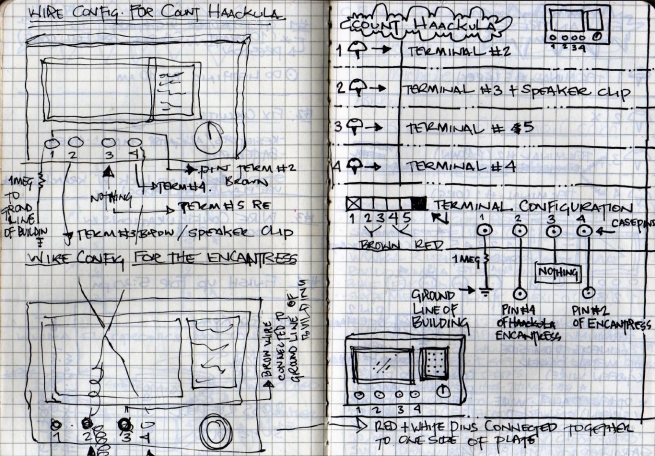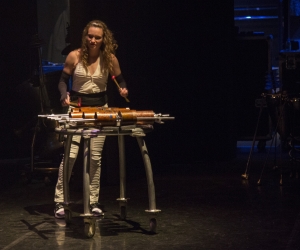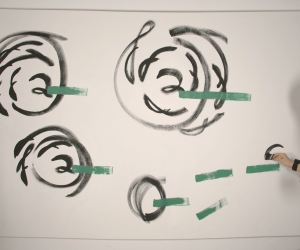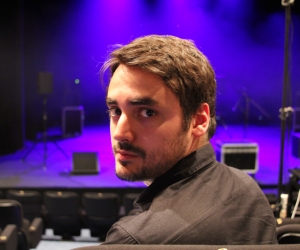
Following the work of Darsha Hewitt is like feeling your way through the inside of an electronic circuit. It is tactile, visceral. Her trial-and-error approach comes from a truly experimental place, and during my conversation with her, I suggest that I have imagined her jotting down observations on a clipboard while wearing a white lab coat, only to be told that her unofficial uniform is “more like a coonskin cap and cowboy boots.” Darsha Hewitt, electronics wrangler?
Hewitt worked as an audiovisual technician while an undergrad, when she was tasked with sorting broken equipment. She realized that items could have lives beyond what was intended for them. A broken projector wasn’t broken—it was just now ready for a life as something other than a projector.
She calls her curious, mindful approach to electronics and radio circuits “free association with electronics”—and it’s not hard to see why. Almost every creation of hers blatantly ignores the original intended purpose of the circuit in favour of exploring what it could be, and seeing how far she can “push it in that weirdo direction.”
I had the pleasure of talking with Hewitt about her process, her origins, and the joys of feeling out an experimental space as with one’s eyes closed.
DAVID McCALLUM: You work with sound—you’re dealing with radio, you’re dealing with hacked and modified electronics for performance—but your background is as a visual artist. Why have you been drawn to sound?
DARSHA HEWITT: When I was making my bread and butter as an a-v technician, I noticed that sound has a way of telling you what’s going on inside the electronics. Sound can be used to tell you something about what’s going on inside a machine, inside an electronic circuit, outside of a machine. And basically it can tap into processes that are going on around us that we, as humans, [with] our big fleshy ears, can’t necessarily hear. So sound—electronic sound specifically—has a way of extracting that sound and giving us a bit of a window into what’s going on beyond our audible perspective.
DM: You’re doing this kind of amazing experimental practice—and by experimental, I mean trial and error, working through things—by getting your hands dirty in the insides of these things. How’d you get started on this track?
DH: Most things that I’ve learned that deal with electronics, I’ve learned on a need-to-know basis. I just sort of started to build electronics, but I was doing the exact opposite of what you’re supposed to do when building audio electronics. You’re supposed to build something that’s insulated, that avoids hums, and that doesn’t have any extra embellishments for potential cross-talk [interference]. But I was more interested in that cross-talk and more interested in how a derailed audio circuit could turn into something that could let you know more about the space that it’s in, or the body of the person that’s manipulating it. That’s how I got started.
DM: Do you have any approach to the aesthetics of the sound you’re creating when you perform? Do you have any approach to the structure of what you’re trying to perform? Or is it really just an exploration of the process of taming these things?
DH: Honestly, it comes down to the building of the device. A lot of the instruments that I make for performances, I designed. Like, I followed a schematic, but it’s not like there’s necessarily a picture of what the end product should look like, or what the controls should be. So I end up integrating upholstery tacks or thumbtacks at places where you’re supposed to touch something. Or I add points where I can stick a jumper cable in and attach it to a radiator in the place where I’m performing. So there is this aspect of extending it beyond its packaged formula of what it’s supposed to sound like.
When I set my stuff up, I’ll sometimes extend parts of the instrument out, so it has, like, tentacles—it sort of reaches out and can sample the air, or it might be informed by the person next to me whose gear set-up has power coursing through it. It might be picking up on that radiation. I’ll have an idea of the sounds that it’s going to create, but there’s going to be interferences along the way. Those are very meaningful to me, so I'll be playing with my instruments, adjusting them as I go along, to pick up on those interferences. I’m basically tuning them to get into a mess. And then I just try to tame it when I’m in performance.
My desire is to have a complete lack of control over what sounds these devices are creating, whereas a lot of people who are building instruments for performing with, the idea is to have the most control, so they can make sense of it when they go and perform in front of a group—which I think is totally valid, but it’s not how I was brought up.
Audio: Experiment (Excerpt, 2009). Performed by Darsha Hewitt. Image: Courtesy of Darsha Hewitt.


